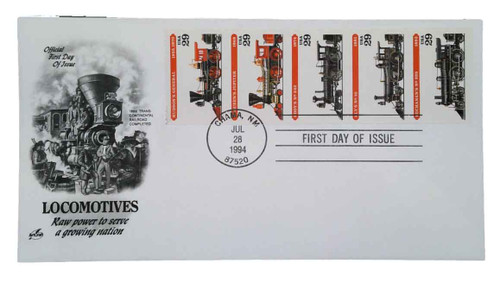
# 2846 - 1994 29c Locomotives: Ely's #10
US #2846
1994 Ely’s No. 10
- Part of set of five picturing American locomotives
- Similar in design to 1987 Locomotive stamps
Category of Stamp: Commemorative
Set: Locomotives
Value: 29¢, First-Class Mail rate
First Day of Issue: July 28, 1994
First Day City: Chama, New Mexico
Quantity Issued: 31,840,000
Printed by: Stamp Venturers
Printing Method/Format: Photogravure. Four panes of five stamps, from printing cylinders of 200 (10 across, 20 down)
Perforations: 11
Reason the stamp was issued: Locomotives are a popular topic with stamp collectors. These stamps appealed to them, as well as train enthusiasts.
About the stamp design: The five stamps picture locomotives produced in America in the last half of the 19th century. Each locomotive was built in a different decade. Richard Leech, who had designed the first set of Locomotive stamps (US 2363-66), worked with his son Kent on the illustrations for these stamps. Richard sketched each locomotive facing left. Kent outlined the work in pen, then Richard finished the artwork with watercolor and airbrush.
First Day City: The Locomotive stamps were dedicated in Chama, New Mexico, the site of the Cumbres and Toltec Scenic Railroad. This route runs from Cumbres Pass to Antonito, Colorado.
About the Set: This stamp is part of a set of five picturing historic locomotives built between 1850 and 1900. Each stamp shows a locomotive constructed during a different decade. Those depicted in this set are: Hudson’s General, McQueen’s Jupiter, Eddy’s No. 242, Ely’s No. 10, and Buchanan’s No. 999.
History the stamp represents:
Theodore Ely (1846-1916) was an executive with the Pennsylvania Railroad when it was one of the largest railroads in the US. He developed steam locomotives. His innovative designs allowed steam locomotives to become more powerful.
A remarkably advanced design at the time of its introduction, Ely’s No. 10 became the model on which later locomotives were based. Designed and built by Ely in 1881, it was among the fastest express locomotives in this country during the 1800s. While previous locomotives had their fire box and boiler within their frames, Ely placed them above the wheels. This allowed for more room to increase the size of the boiler and fire box leading to greater power. When Ely’s first locomotives were seen, sceptics believed they were top-heavy and would topple over. They were proved wrong. The new designs rode smoother than previous locomotives, were more stable, and the fire box was easier to tend. Ely’s No. 10’s remarkable design became the standard for more powerful locomotives that followed.
US #2846
1994 Ely’s No. 10
- Part of set of five picturing American locomotives
- Similar in design to 1987 Locomotive stamps
Category of Stamp: Commemorative
Set: Locomotives
Value: 29¢, First-Class Mail rate
First Day of Issue: July 28, 1994
First Day City: Chama, New Mexico
Quantity Issued: 31,840,000
Printed by: Stamp Venturers
Printing Method/Format: Photogravure. Four panes of five stamps, from printing cylinders of 200 (10 across, 20 down)
Perforations: 11
Reason the stamp was issued: Locomotives are a popular topic with stamp collectors. These stamps appealed to them, as well as train enthusiasts.
About the stamp design: The five stamps picture locomotives produced in America in the last half of the 19th century. Each locomotive was built in a different decade. Richard Leech, who had designed the first set of Locomotive stamps (US 2363-66), worked with his son Kent on the illustrations for these stamps. Richard sketched each locomotive facing left. Kent outlined the work in pen, then Richard finished the artwork with watercolor and airbrush.
First Day City: The Locomotive stamps were dedicated in Chama, New Mexico, the site of the Cumbres and Toltec Scenic Railroad. This route runs from Cumbres Pass to Antonito, Colorado.
About the Set: This stamp is part of a set of five picturing historic locomotives built between 1850 and 1900. Each stamp shows a locomotive constructed during a different decade. Those depicted in this set are: Hudson’s General, McQueen’s Jupiter, Eddy’s No. 242, Ely’s No. 10, and Buchanan’s No. 999.
History the stamp represents:
Theodore Ely (1846-1916) was an executive with the Pennsylvania Railroad when it was one of the largest railroads in the US. He developed steam locomotives. His innovative designs allowed steam locomotives to become more powerful.
A remarkably advanced design at the time of its introduction, Ely’s No. 10 became the model on which later locomotives were based. Designed and built by Ely in 1881, it was among the fastest express locomotives in this country during the 1800s. While previous locomotives had their fire box and boiler within their frames, Ely placed them above the wheels. This allowed for more room to increase the size of the boiler and fire box leading to greater power. When Ely’s first locomotives were seen, sceptics believed they were top-heavy and would topple over. They were proved wrong. The new designs rode smoother than previous locomotives, were more stable, and the fire box was easier to tend. Ely’s No. 10’s remarkable design became the standard for more powerful locomotives that followed.











